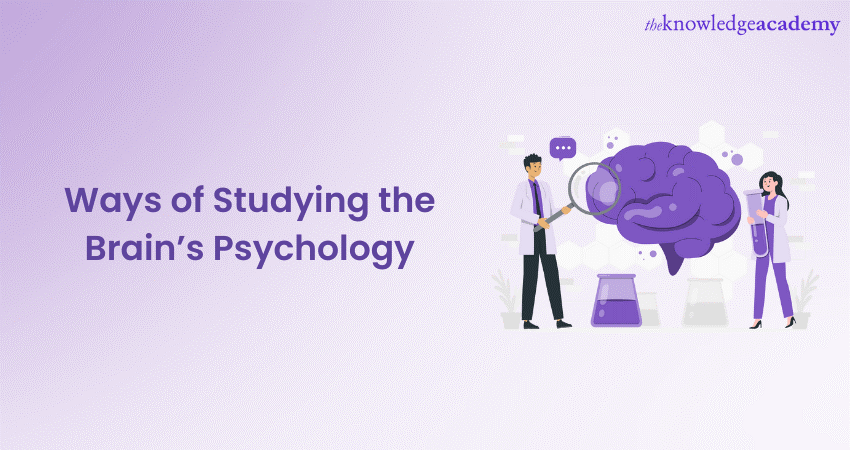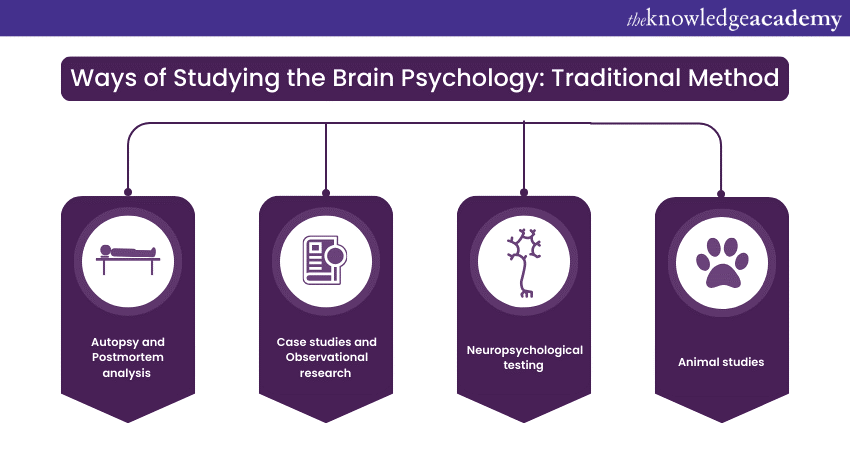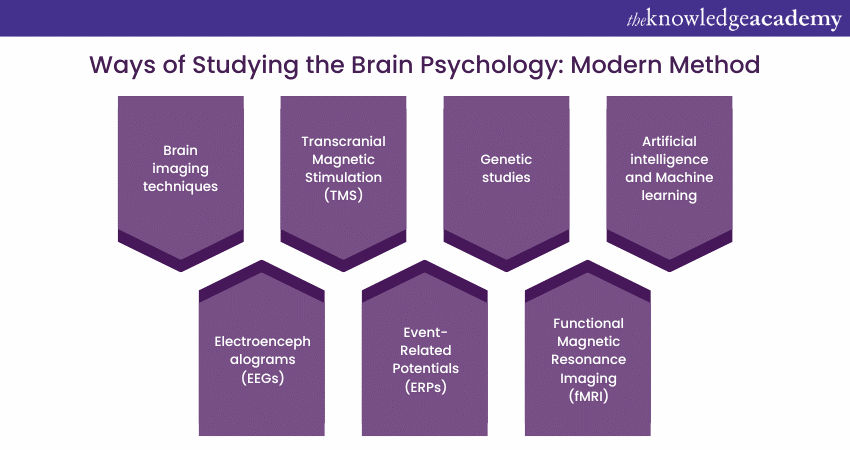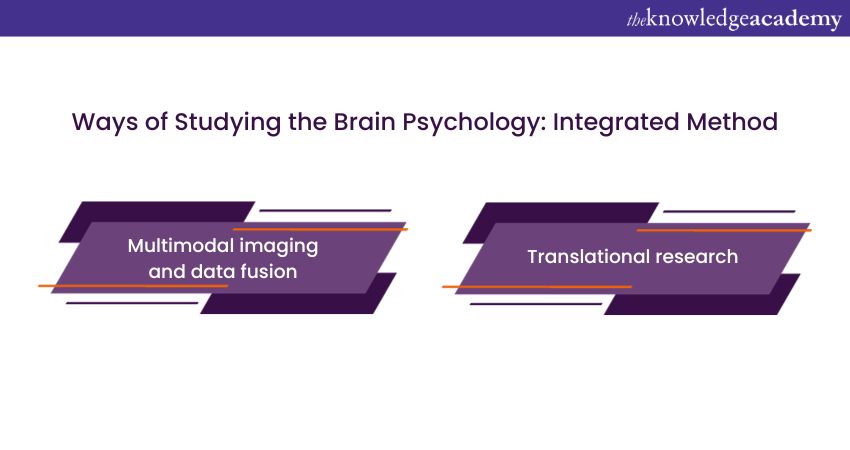We may not have the course you’re looking for. If you enquire or give us a call on +31 208081674 and speak to our training experts, we may still be able to help with your training requirements.
Training Outcomes Within Your Budget!
We ensure quality, budget-alignment, and timely delivery by our expert instructors.

The human brain, with its intricate structure and remarkable functions, is a captivating subject of study. A comprehensive understanding of how the brain influences our thoughts, emotions, and behaviour is crucial for unlocking the secrets of human cognition and Mental Health.
We use different Ways of Studying the Brain Psychology, like MRI, fMRI, PET, EEGs, ERPs, and CT scans.
According to Zippia’s Neuropsychologist Jobs Report, there are over 11,000 cognitive psychologists in the US. The same report reveals that Rehabilitation is the skill most common among these professionals.
This blog explains the Ways of Studying the Brain Psychology , including traditional and modern methods like autopsies, Functional Magnetic Resonance Imaging (fMRI), multimodal imaging, and so on.
Table of Contents
1) Understanding the Brain Psychology
2) Exploring the Ways of Studying the Brain’s Psychology
a) Traditional methods
b) Modern methods
c) Integrated methods
4) Ways of Studying the Brain evaluation
5) Conclusion
Understanding the Brain Psychology
An understanding of the Brain's Psychology is a fascinating field that explores the intricate relationship between the brain and human behaviour, cognition, and emotions. The field of brain psychology encompasses the study of the brain's functions and its impact on human behaviour and cognition. A comprehensive understanding of the brain’s intricacies is crucial for gaining insights into various psychological processes and disorders.
Furthermore, the brain's structure plays a crucial role in influencing various psychological processes and behaviours. It is the command centre of the body, responsible for processing information, coordinating bodily functions, and generating our experiences and perceptions of the world.
Moreover, Brain Psychology aims to unravel the mysteries of how the brain gives rise to our cognitive processes, emotions, memories, and personality traits. Researchers in this field investigate the various key aspects of the brain's psychology, such as:
1) Brain structure: Studying the anatomical organisation of the brain and how different regions and neural networks contribute to specific psychological functions.
2) Brain functions: Exploring how the brain processes sensory information, regulates emotions, forms memories, and performs higher-order cognitive processes like decision-making and problem-solving.
3) Neurotransmitters and Neurochemistry: Investigating the role of chemical messengers, known as neurotransmitters, in transmitting signals between neurons and regulating brain activity.
4) Brain development: Examining how the brain develops from infancy through adulthood, including the formation of neural connections, synaptic pruning, and the impact of environmental factors on brain development.
5) Brain disorders and mental health: Investigating the neural mechanisms underlying various psychological disorders such as anxiety, depression, schizophrenia, and neurodegenerative diseases, with the aim of developing effective treatments and interventions.
Exploring the Ways of Studying the Brain Psychology
The Study of the Brain's Psychology involves employing various methodologies and techniques to understand its functions, cognitive processes, and the complexities of human behaviour. Here is a list of the various Ways of Studying the Brain Psychology :
Traditional methods
Below are the traditional Ways of Studying the Brain Psychology , described briefly:

a) Autopsy and Postmortem analysis
Autopsy and postmortem analysis involves the examination of a deceased individual's body, specifically the brain, to gain insights into its structure and identify any abnormalities. During an autopsy, a trained pathologist carefully dissects the body, removing and examining the brain tissue.
Additionally, this process allows for a detailed examination of the brain's anatomy, including its various regions, lobes, and structures. The postmortem analysis process involves:
a) Studying the brain tissue under a microscope
b) Conducting histological examinations
c) Analysing cellular and molecular changes
Furthermore, autopsy and postmortem analysis provide valuable information about the brain's structure, helping researchers understand the relationship between brain anatomy and psychological functions. The analysis also helps them identify the presence of tumours, lesions, or neurodegenerative disorders and contribute to advancements in diagnosing and treating brain-related conditions.
b) Case studies and observational research
Case studies and observational research are methodologies used in the field of psychology to gather in-depth information about individuals or small groups. Researchers closely examine the behaviour, experiences, and background of a particular individual or group over an extended period, through their work on case studies.
Additionally, this qualitative approach provides detailed insights into specific psychological phenomena or rare conditions. Observational research involves systematically observing and recording behaviours, often in naturalistic settings. Researchers are careful during their observation of participants, where they ensure not to intervene. They allow them to gather rich, real-world data on behaviour and psychological processes.
Moreover, case studies and observational research provide:
a) Valuable qualitative data
b) Offering a deeper understanding of complex psychological phenomena
c) Contributing to theory development
d) Guiding further research in the field
c) Neuropsychological testing
Neuropsychological testing is a comprehensive assessment method used to evaluate an individual's cognitive abilities, behaviour, and emotional functioning in relation to brain function. It involves the administration of a series of standardised tests that assess various cognitive domains, including attention, memory, language, executive functions, and visuospatial skills.
Additionally, these tests provide objective measures of an individual's cognitive strengths and weaknesses, allowing clinicians and researchers to identify and understand brain-related deficits. Neuropsychological testing plays a crucial role in diagnosing and monitoring neurological conditions, such as traumatic brain injury, dementia, and stroke.
More importantly, it also helps in developing personalised treatment plans rehabilitation strategies, and understanding the impact of brain dysfunction on psychological well-being and everyday functioning.
d) Animal studies
Animal studies in the field of psychology involve conducting research on non-human animals to gain insights into various aspects of brain function, behaviour, and psychological processes. Researchers typically utilise animal models such as mice, rats, monkeys, and other species to study biological and behavioural phenomena that are difficult to investigate directly in humans.
Additionally, animal studies allow for controlled experiments, manipulation of variables, and detailed observations in a controlled environment. They provide valuable information about basic brain mechanisms, learning, memory, social behaviours, and the effects of interventions or treatments.
Moreover, while ethical considerations and caution are essential, animal studies play a crucial role in advancing our understanding of the brain's psychology and informing research and clinical practices.
Acquire the knowledge of experimental psychology and human behaviour, by signing up for the Psychology Masterclass now!
Modern methods
Modern methods in the field of Studying the Brain's Psychology involve advanced technologies and approaches that provide researchers with detailed insights into brain structure, function, and behaviour. These Ways of Studying the Brain's Psychology include:

a) Brain imaging techniques: Advanced imaging technologies such as Magnetic Resonance Imaging or MRI, functional Magnetic Resonance Imaging or fMRI, Positron Emission Tomography or PET, and Electroencephalography or EEG allow researchers to visualise brain activity and connectivity in real-time.
For example, Functional Magnetic Resonance Imaging or fMRI is a technique that measures changes in blood flow and oxygenation levels in the brain, providing insights into the neural correlates of specific psychological processes and tasks.
b) Transcranial Magnetic Stimulation (TMS): TMS uses magnetic fields to stimulate or inhibit specific brain areas, allowing researchers to investigate causal relationships between brain activity and psychological functions.
c) Genetic studies: Advances in genetics enable researchers to explore the role of genes in brain development, function, and the risk of developing psychological disorders.
d) Artificial intelligence and machine learning: Utilising Artificial Intelligence (AI) and machine learning algorithms, researchers can analyse large datasets and identify patterns and associations in brain activity, leading to a deeper understanding of the brain's psychology.
e) Electroencephalograms (EEGs): Electroencephalograms (EEGs), are a Brain study method in which electrodes (typically up to 34) are placed on the scalp with conductive gel. These electrodes pick up patterns of activity and electrical signals across the entire Brain and are created by the synchronised firing of numerous neurons.
These patterns manifest as different Brain waves, including Alpha, Beta, Theta, and Delta. The amplitude of these waves represents their size and intensity, while the frequency indicates the speed of Brain activity. By analysing these Brain waves, we can gain insights into a person's consciousness and Brain function.
EEGs are frequently employed in sleep studies, as they can detect changes in Brain wave patterns that correspond to different sleep stages.
f) Event-Related Potentials (ERPs): Event-related potentials (ERPs) share similarities with EEGs because they also rely on electrodes to capture subtle electrical fluctuations in Brain neurons. The key difference lies in the methodology: Researchers expose participants to a stimulus multiple times, and each recorded response wave is integrated into a dataset. This generates a smooth activation curve through a process known as statistical averaging.
Statistical averaging plays a crucial role in ERPs by filtering out extraneous background noise unrelated to the stimulus. This refinement allows researchers to offer the observed activation to the trigger itself confidently. This eliminates the impact of incidental background interference. The resulting waves are indicated by peaks and troughs, which provide insights into Mental Processes within the Brain and are suitably named event-related potentials.
g) Functional Magnetic Resonance Imaging (fMRI): fMRI is a brain imaging method that measures cerebral blood flow while an individual engages in a specific task. The underlying principle of fMRI lies in the fact that brain neurons involved in task-related activities require the most energy. This energy demand is met through the consumption of glucose and oxygen. Oxygen is transported in the bloodstream, bound to haemoglobin within Red Blood Cells (RBC). When active neurons require oxygen, haemoglobin releases it, transitioning from an oxygenated to a deoxygenated state.
Deoxygenated haemoglobin has distinct magnetic properties compared to its oxygenated counterpart. fMRI technology can discern these magnetic differences and construct a dynamic 3D map of the Brain that illustrates the regions involved in various neural activities. Notably, fMRI images reveal Brain activity approximately 1-4 seconds after it occurs and provide an accuracy of about 1-2 mm. An increase in blood flow signifies the heightened demand for oxygen in the actively engaged brain area and reflects an increase in neural activity.
Learn about the various theoretical perspectives on personality, by signing up Introduction to Psychology of Personality Course now!
Integrated methods
Integrated methods in the field of Studying the brain's psychology involve combining multiple approaches and techniques to gain a comprehensive understanding of brain structure, function, and behaviour.
These methods aim to bridge the gap between different disciplines and provide a holistic view of the brain's psychology. Integrated methods may include:

a) Multimodal Imaging and Data Fusion: Researchers can combine multiple imaging techniques such as MRI, fMRI, and EEG, thereby integrating data from different sources to obtain a more complete picture of brain structure and function.
More importantly, researchers can integrate information from different modalities, thereby gaining a deeper understanding of the complex interactions between brain regions and their contribution to psychological processes.
b) Translational research: The traditional approach focuses on translating findings from basic research to practical applications in clinical settings, bridging the gap between laboratory research and real-world interventions.
More importantly, the research approach ensures that scientific discoveries and knowledge are directly applied to improving the diagnosis, treatment, and prevention of neurological and psychiatric conditions, ultimately enhancing the quality of care and outcomes for patients.
Learn to encourage mental wellbeing with our Mental Health and Wellbeing Training!
Ways of Studying the Brain Evaluation
Each brain Study method comes with its unique set of advantages and limitations, especially in terms of their resolution:
Post-mortem examinations offer exceptional spatial resolution, but they cannot establish that the examined areas directly correspond to specific functions. Furthermore, these examinations can only be conducted posthumously, and their findings infer function rather than causally linking it to particular brain regions.
fMRI offers a remarkable spatial resolution, providing detailed information about brain activity. However, it suffers from a comparatively lower temporal resolution. fMRI studies are expensive, but they are also non-invasive, which improves their practicality.
EEGs excel in temporal resolution that offers detailed insights into the timing of brain activity. However, their spatial resolution is relatively poor and limits the detailed localisation of activity.
ERPs, like EEGs, offer an exceptional temporal resolution and capture the timing of neural processes accurately. Nevertheless, their spatial resolution remains limited, which makes it challenging to pinpoint the precise brain areas involved in these processes.
Conclusion
The field of Studying the Brain's Psychology offers diverse ways to explore the intricacies of the brain and its impact on human behaviour and cognition. The Ways of Studying the Brain Psychology are continually evolving, from traditional methods like autopsies and case studies to modern techniques such as brain imaging and genetic studies.
Enhance your leadership skills by learning to identify and manage workplace stress with our Workplace Stress And Mental Health Identification For Manager – Sign up today!
Frequently Asked Questions
Upcoming Health & Safety Resources Batches & Dates
Date
 Psychology Course
Psychology Course
Fri 14th Feb 2025
Fri 11th Apr 2025
Fri 13th Jun 2025
Fri 15th Aug 2025
Fri 10th Oct 2025
Fri 12th Dec 2025







 Top Rated Course
Top Rated Course



 If you wish to make any changes to your course, please
If you wish to make any changes to your course, please


